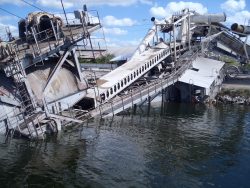What is an Emergency Response Plan, and How Can It Protect Industries?
Unfortunately, the 2017 hurricane season has been devastating so far and we keep those impacted in our thoughts. Although we are in the midst of hurricane season, it is never too late to plan, prepare, and position your company to better respond to emergency situations. Below we highlight some of the basics companies can do to minimize impacts to the community and environment should they be impacted by a hurricane or other disaster.
Having a good Emergency Response Plan (ERP) and training is critical to limit injuries and damages to property and the environment. If a company doesn’t have a good ERP, the first step is to establish a planning team or engage an environmental consultant to help create a plan. A few critical elements to a good ERP include:
- Shutdown procedures
- Evacuation routes
- Accountability of personnel
- Identifying the response team and cleanup contractors
- Notifications to agencies and stakeholders
- Site security and control
- Incident Command System (ICS) fundamentals and forms
Once a good ERP is established, the next step is to train key personnel on the ERP so they can execute the plan when needed. The basics of training on an ERP include:
- Orientation and education sessions
- Tabletop exercises
- Drills
- Full-scale exercises with agencies and key stakeholders
Performing drills and exercises at minimum annually will help identify gaps or shortcomings in the ERP. Auditing and modifying the plan annually, and briefing personnel on these changes, is crucial to a well implemented ERP.
If a company suffers unfortunate impacts by a hurricane or other disaster, how they respond can greatly affect impacts to the community and environment. A well run response will help reduce these outside impacts, as well as damage to the company’s reputation, while reducing the time and cleanup costs associated with response efforts. Important objectives to consider during a response include:
- Life safety
- Control/stop the source
- Contain/recover product
- Site security/control
- Minimize impacts to the community/environment/property by delineating the impact and quickly remediating the impact
- Keep the public and stakeholders well informed
These basic guidelines are just some of the precautionary steps companies can take to minimize disaster impact. Additional information may be found on the FEMA website or by contacting EnviroScience at (800) 940-4025.
EnviroScience has been helping clients manage and mitigate large-scale environmental incidents since 1989. Read more about EnviroScience’s emergency response services here.
